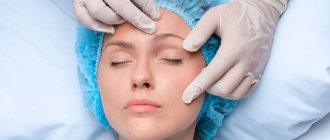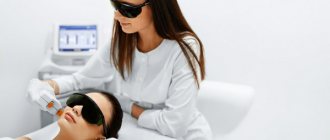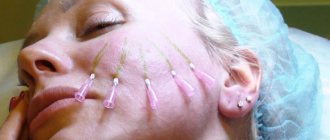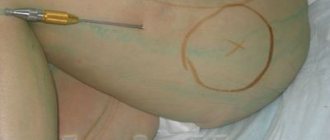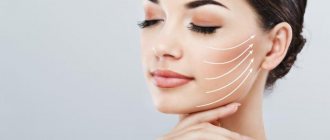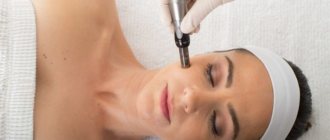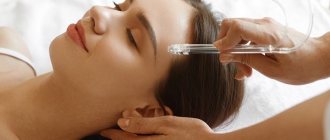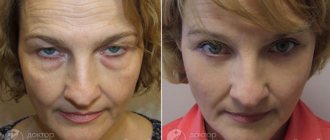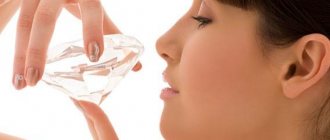Full rehabilitation after a circular facelift as a rejuvenating procedure is considered an invariable condition. The circumferential lift has several alternative names - rhytidectomy or facelift. And although this procedure is considered relatively new, it already has many fans around the world. And indeed, why go under the knife of a plastic surgeon if there is the safest and most effective tightening technique?
Of course, like most cosmetic procedures, a circular lift has a number of contraindications and possible side effects. But the high-quality work of a competent craftsman will negate all possible risks. And some of the difficulties of the rehabilitation period are forgotten at the sight of young and beautiful facial skin.
How long does rehabilitation take?
The rehabilitation period after a circular facelift can take some time. Moreover, the time period required for complete recovery is individual for each patient. The speed of rehabilitation directly depends on the patient’s age, the characteristics of her skin and general health.
As a rule, if the operation was successful and did not cause any side effects, rehabilitation after a facelift goes quite quickly. 3 weeks after the operation, the patient can begin to perform her work duties.
The average duration of the rehabilitation period after a circular lift takes 1-2 months.
Rehabilitation after a facelift
With the advent of age-related changes, many women resort to facelifting - plastic surgery, as a result of which the face regains youth, freshness and attractiveness. The result of the intervention depends on the professionalism of the plastic surgeon, but this is not the only criterion for success.
Rehabilitation after a facelift is the most important stage during which tissue regeneration and scar formation occur. The average recovery period is about 2 months. The duration of this period is influenced by factors such as the patient’s age and the condition of her skin, and compliance with recommendations after the intervention.
How does rehabilitation proceed, why is it important to adhere to the regime, what should it be and when to expect the final result? Our permanent expert, plastic surgeon Gleb Igorevich Tumakov, helps TecRussia.ru understand these issues:
↑ Feelings after surgery
Despite the assurances of some surgeons, facelift is a traumatic surgical procedure that is associated with discomfort during and after the intervention.
- The pain in the first hours is mild - this is due to the use of anesthetic drugs during plastic surgery. As their effect weakens, the discomfort may intensify - in this case, taking analgesics is allowed. Which ones specifically - it is better to consult your doctor in advance.
- There may be a feeling of tightness behind the ears associated with platysmaplasty, especially when turning the head. Minor discomfort sometimes occurs due to the fact that traces of biological fluids (blood) remain on the hair. But you can’t wash your hair for another 3-5 days.
- Due to severe swelling, some patients initially experience the effect of a “strange face” and facial expressions are disturbed. To reduce swelling, the doctor may prescribe diuretics - Furosemide, Diacarb.
↑ How is rehabilitation going? Recovery time by day and month
Only the first few days after plastic surgery will be difficult for the patient, but it will take quite a long time for the face to reach its final appearance. In addition, the scar will form over six months to a year, going through all the standard stages of maturation. This does not mean that such a long period of time will have to be spent hiding from prying eyes: the main traces of intervention disappear much faster.
↑ First day after surgery
Having completed the surgical procedures, the doctor immediately applies a fixing bandage to the patient. Its purpose is to reliably fix the facial tissues and prevent the seams from coming apart. If the operation was completed without complications, the patient is sent home on the same day with subsequent outpatient monitoring.
- The results of a circular lift are already noticeable. But severe swelling and hematomas still prevent it from being fully assessed. There is no need to be afraid of this; the main thing is to strictly follow the surgeon’s recommendations and take the medications prescribed by him.
- Active chewing movements can provoke pain - in the first days it is better to give preference to liquid, pureed foods, for example, pureed soups, cereals, yoghurts.
- It is recommended to sleep on your back - this will help minimize discomfort, speed up healing, as well as reduce swelling and avoid asymmetry.
- As after any other operation, alcohol, smoking, and taking medications that thin the blood are prohibited.
- Active sports are not recommended. But doctors also do not recommend lying down a lot - the tissues of the face can “float”. Walking in the fresh air and light exercises are helpful.
- There are no restrictions on household loads. But it is advisable to avoid work that involves tilting the body, for example, washing floors by hand.
↑ 3–5 days after surgery
During this time, the patient must undergo regular dressing changes. The sutures located in front of the ears are removed, and instead special adhesives are applied to hold the skin in the desired position and prevent it from moving.
- The pain, as a rule, no longer bothers you, but if it persists, be sure to tell your doctor about it. The swelling and bruising still look quite scary, but are gradually disappearing.
- You can wash your hair. This must be done very carefully, avoiding sudden movements - especially in the area where the seams are located.
- To avoid the development of infectious complications, the surgeon prescribes a course of antibacterial drugs.
- To speed up regeneration and prevent secondary inflammation, wound healing ointments or gels (Traumel, Bepanten) can be applied to the incision sites.
- It is recommended to properly alternate sleep and rest modes, it is important to get enough sleep regularly and not to forget about reasonable physical activity.
↑ 2 weeks
On days 12–14, the doctor removes the remaining sutures. Traces of surgical intervention can be disguised with light makeup. This means that the patient can return to work and lead a normal lifestyle with only minor restrictions.
- By this time, bruises and pronounced swelling disappear. Pulling sensations in the neck when turning the head also usually disappear.
- Exposing your skin to ultraviolet rays is prohibited; when going outside on a sunny day, you must apply sunscreen to your face.
- There are no strict dietary restrictions, but it is advisable to refrain from eating spicy, pickled, overly salty and spicy foods. Doctors also do not recommend drinking alcohol.
↑ 1 month
Time to lift most bans. Swelling, provided that all rehabilitation rules are followed and there are no complications, practically disappears.
- Scars in front of the ear become less noticeable. There comes a time when the patient can fully enjoy the result obtained.
- Some restrictions remain: you need to refrain from active sports, avoid direct exposure to sunlight on the suture area. If there are individual indications, the ban on sun exposure may be extended.
↑ 2–3 months
The swelling goes away completely. The face becomes absolutely natural, facial expressions are not disturbed.
↑ Six months
The scar is still in the process of formation, but already looks quite neat. After another 6 months, the scar takes on its final form - it is barely noticeable and can be easily disguised with makeup.
↑ Is it possible to speed up rehabilitation?
In the absence of complications, the operating doctor gives permission to carry out additional procedures aimed at improving regeneration processes and the formation of a neat, unnoticeable scar. The cosmetologist determines the need for physiotherapy and prescribes them in accordance with the individual characteristics of the patient.
Such procedures help speed up the recovery period.
Tumakov Gleb Igorevich Leading plastic surgeon at Frau Klinik, expert of the “Reboot” project on the TNT channel
In my practice, I pay special attention to preserving the natural anatomy of the patient’s face and do not overtighten the skin to avoid a mask effect. This is the only way to achieve the most natural result. The experience of my patients confirms this. After the operation, their youth returns and they feel desired again. The more you like yourself, the more pleasure you get from life. If you feel that plastic surgery can improve your life, but have doubts, come for a consultation. Together we will select a method that is right for you.
- Deep SMAS lifting: what you need to know about the new deep facelift technique
- Anti-aging surgeries in the face and neck area: educational program from Dr. Tumakov
↑ Are there complications?
Both during the facelift and during the recovery period, negative consequences may develop. And the plastic surgeon must familiarize the patient with their list - especially if there are individual characteristics of the body, intolerance to anesthetic drugs. In addition, the doctor needs to explain in detail what the consequences of violating the recommendations during the rehabilitation process are.
The most common complications associated with the specifics of performing a facelift:
- Marginal necrosis behind the ears. A small crust forms at the site of the incisions or detachment of the epidermis occurs. The problem is provoked by deterioration of blood supply in this area.
- Transient malnutrition of the skin flap. In this case, the seam takes longer to form and heal and looks rougher. The problem can be corrected surgically, as well as with the help of camouflage tattooing or laser. As a rule, there are no serious consequences for the patient.
- Bleeding in the early postoperative period. The solution to the problem is repeated intervention.
- The development of gray - cavities in the subcutaneous fat filled with serous fluid. They are quite rare and often resolve on their own. But the appearance of formations increases the risk of infection and can lead to inflammation of the integument and their detachment.
| You can make an appointment with Dr. Tumakov: • by phone. • or through the online form • clinic address: Moscow, st. Lefortovo Val, 5, building 7 |
Recovery period
The recovery period after the facelift procedure has a number of features:
- A circular facelift leaves multiple swelling on the patient’s face. They are the result of disruption of small vessels during surgery. To solve this problem, a special compression bandage is applied to the woman’s face. In the case of normal functioning of the body, with the help of this bandage, swelling disappears already 4 days after the intervention. Hematomas appear much less frequently than edema. As a rule, all external manifestations of the postoperative period disappear on the 10th day after surgery.
- A circumferential face and neck lift is not considered a complex operation. For this reason, to relieve possible pain, it will be enough to take regular painkillers.
- As a rule, sutures are removed on the 3rd day after surgery. They are replaced with special strip strips.
Due to the tightening of the dermis and the removal of excess fat from the subcutaneous space, the patient may feel discomfort in the form of tightness of the skin at the incision sites. The affected areas may also experience tingling and numbness. Usually these symptoms go away on their own after the skin has completely healed.
You will learn more about restoration from the video:
Why complications may occur
Plastic surgery is a surgical procedure like any other. It occurs with tissue damage, which is necessary when general anesthesia is administered. The operation is performed not just by a surgeon, but by a specialist who has undergone appropriate training. The intervention is complemented by a rehabilitation period, which has its own characteristics. That is, rejuvenation itself does not occur instantly, but will consist of several stages. And deviations in any of them can cause complications after a facelift. The causes of their occurrence can be clearly divided into groups:
- Carrying out an endoscopic facelift.
Doctor's mistakes . They may relate to violations of the technique of performing the operation (dissection of tissue, maintaining blood supply to different parts of the face, suturing) or neglect of the rules of sterility. This reason causes several complications at once, or first one of them. But then the problem along the chain entails others.
- The patient's diseases and body characteristics . Plastic surgery is no longer performed by young people who may have problems such as high blood pressure and elevated blood glucose levels. They affect the speed and quality of tissue healing and pose obstacles to the normal rehabilitation process. The characteristics of the body may not be recognized before surgery. This, for example, is a tendency to form hypertrophic scars and rejection of suture material.
- Violations of the rules of the rehabilitation period . In order for regeneration to take its course, you have to give up a lot for a while and make some efforts. If the patient is in a hurry to return to his previous life and habits, this can disrupt the restoration processes in the healing tissues. Smoking occupies a special place in this group of causes of complications.
We recommend reading about surgical facelift. You will learn about what this plastic surgery is, who it is indicated for, contraindications for it, the stages of a facelift and the recovery period. And here is more information about face lifting with mesothreads.
Recommendations from cosmetologists
To ensure that facelift tightening does not cause unforeseen complications, you should follow simple cosmetic recommendations in the postoperative period:
- The patient is recommended to sleep exclusively on her back for at least 2 weeks for faster tissue restoration and consolidation of the positive effect obtained.
- For six months after the intervention, you should avoid visiting the solarium and exposing your face to direct sunlight.
- Follow a daily routine and diet.
- Optimal alternation of physical work and rest.
- Also, a woman should minimize sports activities at least for the first time after a facelift.
- It is not recommended to use aspirin and other anti-inflammatory drugs 2 weeks before and after surgery.
- Cold compresses for the eyes using gauze or soft cloth will have a good effect.
- The first time after the procedure, it is recommended to sit, stand and walk more to consolidate the resulting tightening effect.
- It is worth taking antibiotics for 5 days to avoid possible inflammatory processes.
Compliance with all the basic rules of the recovery period will help the skin remain beautiful and tight for a long time after the rhytidectomy procedure.
How to speed up healing at home
The most important thing in the rehabilitation period is the patient’s compliance with medical recommendations.
The doctor will certainly tell you about the importance of leading a healthy lifestyle and explain what you can do and what you can’t do.
Get ready to limit yourself in physical activity and follow a diet: nothing hard, spicy, too salty, a minimum of tea and coffee.
Washing your hair is allowed only 2–7 days after the procedure, and you need to sleep in a certain position. The first year after facial plastic surgery you should not sunbathe. To speed up the healing of wounds and eliminate side effects, you can use additional agents and medications.
For the first 7–14 days, you should not wash or paint your face. 1 week after plastic surgery, the doctor may allow you to use cleansers that do not require rinsing: cream, milk.
To moisturize your skin, choose an alcohol-free toner or lotion. It is advisable that the product be intended for dry or normal dermis, even if you used other products before facial plastic surgery.
Choose the most natural, hypoallergenic cosmetics without fragrances or dyes. Thick, textured creams, especially in the area of facial plastic surgery, are prohibited!
But drugs with a tightening effect and intended for skin regeneration are quite appropriate. To cool your eyelids after blepharoplasty or canthoplasty, buy a special mask in the form of glasses.
Use professional products
Before any cosmetic procedures, it is important to obtain the approval of the doctor who performed the facial surgery on the patient.
For example, a cream with a volume of 50 milliliters will cost from 4,500 rubles, and a cooling and soothing serum (15 milliliters) will cost over 3,000 rubles. Also, after facial plastic surgery, you can use Planetary Herbals horse chestnut cream (1000 rubles for a 113 gram jar). It moisturizes the skin, improves blood circulation, and relieves puffiness.
There are other cosmetics that can be used after facial surgery. Buy something that suits your skin and won't put too much of a strain on your family budget.
A multivitamin complex will help reduce swelling and bruising, as well as speed up the rehabilitation process. Choose a drug that contains ascorbic acid, vitamins K and A - these beneficial substances strengthen the walls of blood vessels and accelerate tissue healing after facial plastic surgery. For the same purpose, doctors prescribe other medications to patients (orally and locally). For example:
Venarus - from 600 rubles for 30 tablets;
Phlebodia - from 650 rubles for 15 tablets;
Troxerutin gel - from 40 rubles per tube;
Heparin ointment - from 60 rubles.
To eliminate scars or prevent their appearance, you can use the Mepiform patch (approximately 1,200 rubles).
According to the doctor's decision, a patient who has undergone facial plastic surgery and is in hospital treatment can undergo special procedures. They shorten rehabilitation time and help the body recover faster. Such techniques include:
- Ultrasound therapy. Has an analgesic, anti-inflammatory effect, improves blood flow.
- Magnetotherapy. Accelerates tissue regeneration and collagen synthesis.
- Microcurrent massage. It alleviates the condition of the patient whose face hurts after plastic surgery, and also reduces swelling, improves metabolism, and normalizes the functioning of the sebaceous glands.
- Cryotherapy is exposure to cold. Pain relieves and relieves inflammation after plastic surgery.
- Mesotherapy and biorevitalization. Hyaluronic acid injections help moisturize the skin, restore its elasticity, accelerate blood flow and shorten the recovery period.
The cost of physical therapy after plastic surgery depends on the clinic. The number of procedures and the frequency of their completion by the patient is determined by the doctor.
Nutrition
During the first time after surgery, a woman may experience difficulty eating, especially if the oral cavity has been affected. During the entire rehabilitation period, the patient is recommended to adhere to a diet, eating only liquid food. Gradually, a transition is made to softer foods and, finally, a return to the usual diet.
Various juices, broths, jelly and yoghurts are especially useful during the recovery period. The latter is especially relevant during this period, because yogurt restores intestinal microflora, which can be disrupted by taking antibiotics.
Recovery at home
The correct rehabilitation course after plastic surgery includes proper patient care for the operated area of the skin. This allows you to shorten the duration of skin restoration.
Lifestyle after completion of any type of facial plastic surgery involves following certain recommendations.
Important:
- abstain from alcohol and smoking;
- completely eliminate sports and physical activities that increase blood pressure (especially after liposuction, mammoplasty, rhinoplasty);
- avoid sunbathing and staying in a sauna, swimming pool, bathhouse;
- monitor your body posture at night;
- adhere to the diet recommended by the plastic doctor and the use of multivitamin formulations;
- Avoid medications not recommended by your doctor, including anticoagulants.
A lenten menu with cereals and soups is considered preferable; low-fat varieties of fish and meat are acceptable.
Fruits and vegetables are consumed in unlimited quantities; seasonal fruits with a high content of vitamins are especially useful. Defecation is normalized by eating dried fruits and other plant products.
Strongly brewed tea and coffee are natural stimulants and should not be drunk. They will be replaced by distilled water in the required volume.
After anesthesia, the best recovery agents are vitamins and rest. Those who have undergone anterior cruciate ligament surgery will benefit from recommendations regarding rehabilitation from specialists Tikhilov and Trachuk.
What can you do after the operation?
The recovery period after a circular facelift involves some changes in the patient’s lifestyle and habits. In order for the recovery to be as quick and successful as possible, a woman should take into account some subtleties. So, in the postoperative period, the patient is allowed to:
- On day 2-3 you can wash your hair; a visit to the hairdresser after a total facelift is possible on day 7-8.
- On the 10th day, it is permissible to apply light makeup to the face.
- After a month, you can perform a lymphatic drainage massage procedure.
- At the end of the rehabilitation period, it is permissible to consolidate the tightening effect with the help of mesotherapy or Botox injections.
How to avoid difficult consequences
To perform facial plastic surgery, it is important to choose a good specialist. But the further result depends not only on it and the quality of the operation performed. In many ways, recovery after a facelift is the patient's concern. It consists of the following:
- For the first 8, 10 days you will have to eat warm liquid or pureed dishes. This is necessary to reduce physical activity, which is still contraindicated. Sports are also prohibited for the next 2, 3 months.
- You will have to watch out for restrictions in expressing emotions. Active facial expressions are undesirable at first, as they can cause damage to the scars.
- Sutures should be treated with the products prescribed by the doctor. Usually these are alcohol solutions or antibacterial ointments.
- You are allowed to wash your hair 8 days after surgery. Use cosmetics no earlier than after 10, 14 days.
- It is important to drink a lot of water and avoid coffee and alcohol for now. Drinks dry out the skin, interfering with the healing of stitches.
- You should stop smoking. Tobacco disrupts collagen formation, meaning it interferes with healing.
- You will have to postpone until later a hot bath (replacing it with a warm shower), sauna, solarium, beach, swimming in a pool or open water. After plastic surgery, these pleasures are provocateurs of complications.
Restrictions after surgery
The rehabilitation period after rhytidectomy imposes certain restrictions on the patient. So, at first it is not recommended for her:
- Drive a car (the first week after the procedure);
- Do a facial massage;
- Swim in pools and open water;
- Smoking and drinking alcohol;
- Lighten and dye hair.
What tests will be required before facial plastic surgery?
Before the operation, the patient must undergo a complete medical examination to identify general health and possible contraindications. The minimum list of necessary preoperative studies includes:
- General blood analysis.
- Biochemical blood test (total protein, ALT, AST, total bilirubin, creatinine, urea, glucose, electrolytes).
- General urine analysis.
- Analysis for blood group and Rh factor.
- Blood test for HIV, syphilis and hepatitis B and C (HBsAg, HCV).
- Blood test for coagulogram.
- ECG.
- Fluorography.
The therapist gives a conclusion about readiness for surgery. If there are concomitant diseases, then consultation with a specialized specialist will be required. To prepare for anesthesia, you will need to visit an anesthesiologist.
Complications after surgery and side effects
In case of insufficient preliminary examination of the patient’s body before the tightening procedure, certain difficulties may arise at the exit. Thus, the most important side effects after a circular facelift surgery are:
- Inflammation at the incision sites. Formed as a result of insufficient preliminary disinfection of work areas.
- Damage to the facial nerve. It can form due to insufficiently qualified actions of a plastic surgeon.
- Facial asymmetry. Occurs due to uneven tissue distribution.
- The appearance of keloid scars. It is considered an individual reaction of the body to making incisions.
- In some cases, postoperative sutures are clearly visible. Usually this problem is solved by using absorbable ointments.
- Excessive stretching of the skin.
In addition to scarring, swelling and possible bruising, the following complications may occur after a circular facelift:
Necrosis . Ignoring problems with sutures can cause a complication in the form of necrosis - tissue death. This problem can occur as a result of too much tissue tension or detachment. As a result, the seam line does not close. The area around the ears is especially susceptible to necrosis. In addition to medical errors, the cause of necrosis can be the presence of diabetes mellitus or atherosclerosis in the patient.
Wound suppuration . Hematomas, necrosis, and the entry of various foreign bodies into the wound provoke inflammatory processes and the release of purulent fluid. To avoid such a problem, the wound area is washed several times during the operation, and upon completion, a drainage system is installed to drain excess fluid.
Deformation of the oval face . Sometimes patients complain of persistent subcutaneous lumps after surgery. The problem is usually corrected with repeat surgery.
Hair loss . Postoperative sutures are often located on the scalp. For this reason, there is often a significant reduction in the amount of hair in the parotid and temporal zones. The main factor is considered to be damage to the skin and hair follicles. In most cases, the problem resolves on its own 3-4 months after the lift. If this does not happen, it is necessary to excise the scar interfering with growth or transplant skin from other areas.
What complications occur?
The list of expected unpleasant consequences includes:
- injury to the facial nerve, which can lead to disruption of the innervation of the muscles responsible for facial expressions;
- asymmetry of the face or hyperextension of the skin surface due to erroneous fixation of the epidermis and muscles;
- applying wide stitches, then the scars on the face will appear;
- The formation of keloid scars occurs due to improper preoperative examination or the characteristics of the patient’s body.
Plastic surgery is a serious procedure, so careful preparation for it cannot be ignored. A high-quality examination and the competence of the surgeon will allow you to obtain the planned result.
Photos before and after surgery and recovery
Real photos of the results of a circular facelift will help you evaluate the effectiveness of the procedure. It is easy to notice the amazing effect after using this rejuvenating technique.
A circular facelift is a modern, safe and effective way to correct facial contours and problem areas. Of course, the maximum effect will be achieved if all safety rules are observed and the doctor’s qualifications are followed. Therefore, the patient should approach the choice of a lift specialist as carefully as possible.
Useful video
To see how a circular facelift differs today from the same operation 5-10 years ago, watch this video:
Facelift surgery can eliminate the marks left by time. But only if the patient does not rely only on the doctor’s art. The result is also achieved through one’s own efforts after the operation. The examination before it is no less important.
Similar articles
- Facelift: complications after a circular...
Facelift for many becomes a real chance to correct imperfections. However, a facelift also provokes complications and is not an absolutely safe procedure. What can you expect with endoscopic lifting, threads, etc.? Read more - Spacelifting: before and after the procedure, what the face looks like
The spacelifting procedure before and after gives a significant effect for problem areas of the face. It is important to know all the features of its implementation and recovery in order to get the maximum result. Read more
- Face after threads: complications, rehabilitation, benefits...
You can rejuvenate and tighten your skin with thread lifting. However, to avoid complications, care and the right choice of clinic are necessary. What does your face look like after threads? When will the effect be visible? How to get rid of complications - bruises, fibrosis, asymmetry. Is it possible to drink alcohol after mesothreads? Read more
- Max lifting or short scar face lifting…
MAX-lifting will help you get rid of scars. This is a fairly new procedure, also called short-scar lifting. Thanks to the before and after effect, it has become one of the most popular. Read more
